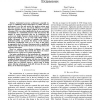Free Online Productivity Tools
i2Speak
i2Symbol
i2OCR
iTex2Img
iWeb2Print
iWeb2Shot
i2Type
iPdf2Split
iPdf2Merge
i2Bopomofo
i2Arabic
i2Style
i2Image
i2PDF
iLatex2Rtf
Sci2ools
SASP
2008
IEEE
2008
IEEE
Resource Sharing in Custom Instruction Set Extensions
Abstract—Customised processor performance generally increases as additional custom instructions are added. However, performance is not the only metric that modern systems must take into account; die area and energy efficiency are equally important. Resource sharing during synthesis of instruction set extensions (ISEs) can reduce significantly the die area and energy consumption of a customized processor. This may increase the number of custom instructions that can be synthesized with a given area budget. Resource sharing involves combining the graph representations of two or more ISEs which contain a similar sub-graph. This coupling of multiple sub-graphs, if performed naively, can increase the latency of the extension instructions considerably. And yet, as we show in this paper, an appropriate level of resource sharing provides a significantly simpler design with only modest increases in average latency for extension instructions. Based on existing resource-sharing techniques, th...
| Added | 01 Jun 2010 |
| Updated | 01 Jun 2010 |
| Type | Conference |
| Year | 2008 |
| Where | SASP |
| Authors | Marcela Zuluaga, Nigel P. Topham |
Comments (0)

